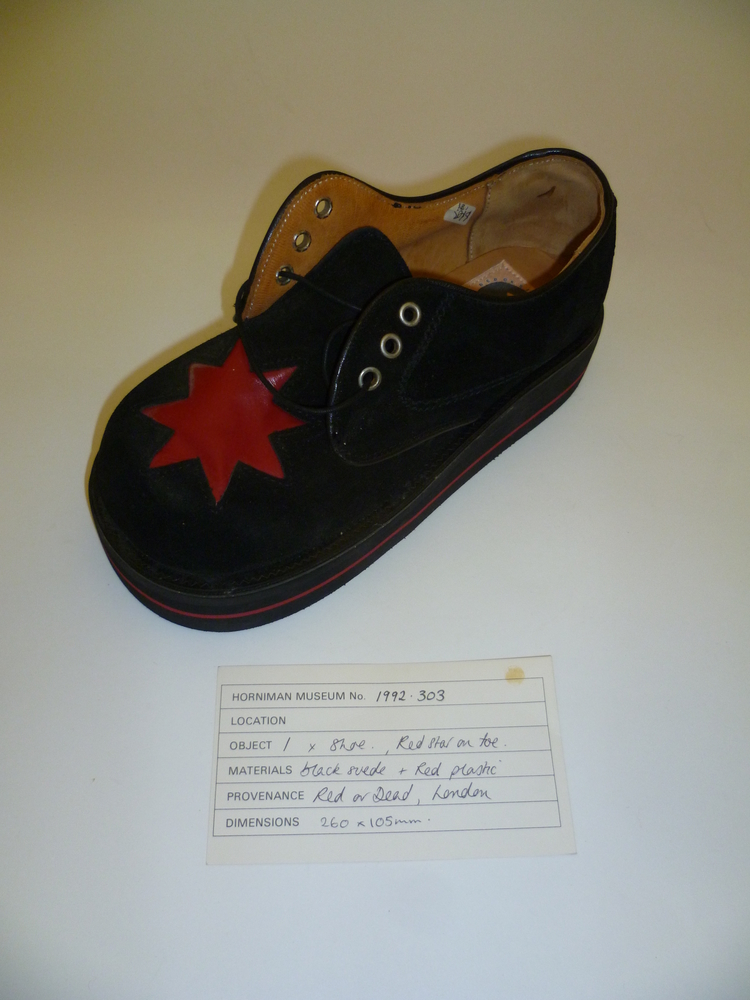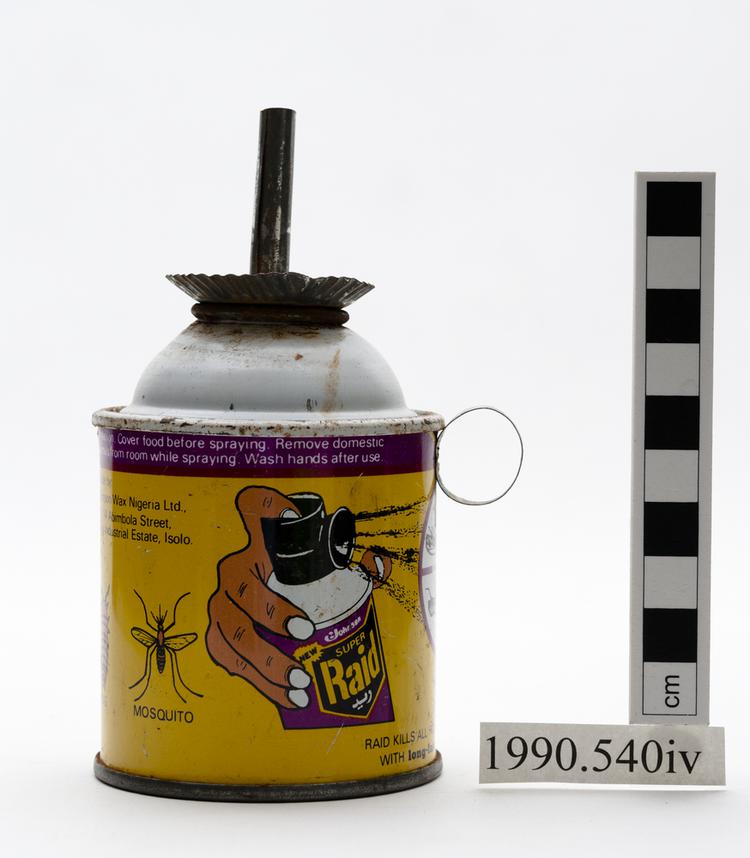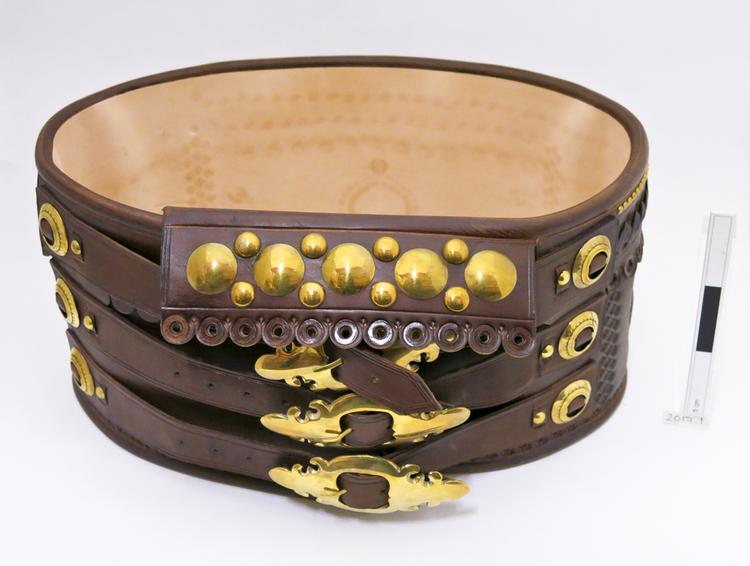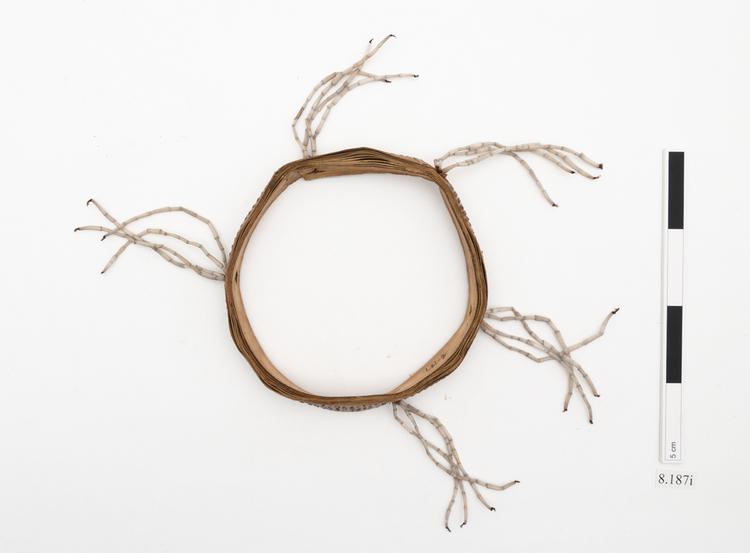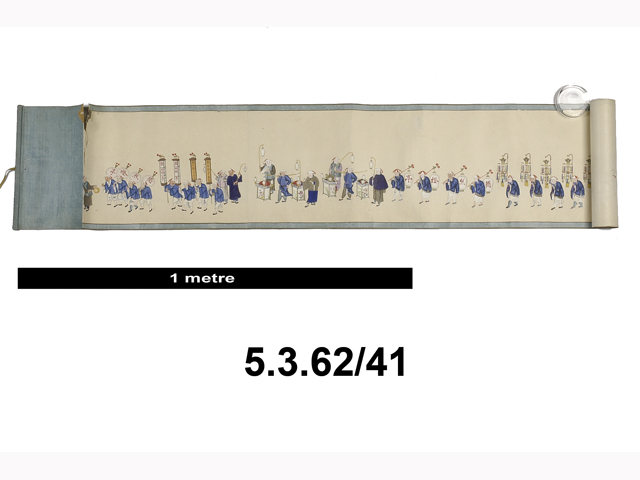
Watercolour picture on paper depicting a procession, almost certainly that of the Empress of Heaven, in Tianjin. The scene runs horizontally on strips of paper stuck together; the whole forming a roll fixed to wooden slats. The scroll ties closed with length of material with a sliver of bone or ivory attached. This painting might be of the ‘pagoda guild’, in which people carry two sedan chairs decorated with red lanterns. Within the first sedan chair called 德照 ‘De Zhao’(which means ‘the glittering virtue’), there is a silver tripod; the second sedan chair called ‘Hai Don Ting’(which means ‘the pavilion of sea’) is filled with water, with lotus and fishes inside. And at the end of the procession, they will carry a huge seven tiered pagoda. This scroll appears to depict such items. In the group consisting of four men with round lanterns and four men with vertical banners behind, all following a figure carrying a yellow orb, the characters on the round lanterns read 德 照 燈 亭 ‘De Zhao Don Ting’ respectively, and combining them together, they mean ‘The pavilion of the glittering virtue’, which is the guild’s name. The next four white and orange banners read the same. In a second similar group the four round white lanterns read: 三 營 擺 馬 ‘san ying bai ma’, which has no meaning but refers to the guild’s name. The two white banners following read: 三營擺馬老會 ‘san ying bai ma lao hui’. The word ‘Lao hui’ means the guild. In a group of eight men holding tablets over their shoulders, the first four tablets read: 迴避 ‘hui bi’, meaning ‘stand aside’; and the next four tablets reads 肅靜 ‘su jing’, which means ‘be quiet’. These two kinds of tablets were often used in an emperor’s guard. In a later group of eight men, the first four with round lanterns, the next four with banners, following a man with a drum, the first four white lanterns read 香 斗 老 會 ‘xiang dou lao hui’, which means ‘The guild Xiang Dou’. The next two white banners read: 天津香斗老會, which refers to ‘the guild Xiang Dou in Tianjin’. The two yellow banners read: 南門內接香 ‘nan men nei jie xiang’. ‘Jie Xiang’ literally means to ‘receive the incense’, but here it is a particular term used in this ceremony means ‘to pass on to’. ‘nan man nei’ means ‘inside the South Gate’. Together this might mean ‘to pass on to the people in the south gate’.
This is almost certainly a painting of Mazu (or ‘Tian Hou’, meaning ‘Empress of Heaven’) Patrol and Pilgrimage in Tianjin City in the Qing dynasty. According to 天津皇會考 ‘Tianjin Huang Hwei Kao’, a Qing dynasty book that depicts the scenery of the fair called ‘Huang Hwei’ held by the Tian Hou Temple in Tianjin, the ceremony takes place once a year to celebrate Mazu’s birthday on 23rd March. They start to prepare the fair from 15th March, and it will last for 7-8 days until Mazu’s birthday. Each day has different goals: the first few days focuse on the patrol of Mazu, and on the last day (her birthday) the most brilliant performances will be held inside the temple. The believers will be divided into several different groups for the procession, with each group in charge of a certain kind of performance. They often carry their own flag with their group name on it when walking in the procession. Each group will be assigned a position in the procession so that they can line up one after another in order. The book records 25 groups, but also notes that there may be some difference among places. This painting might cover group No. 17 ‘pagoda guild’. In this guild, people will carry two sedan chairs which is decorated with red lanterns. Within the first sedan chair called 德照 ‘De Zhao’(which means ‘the glittering virtue’), there seats a silver tripod; the second sedan chair called ‘Hai Don Ting’(which means ‘the pavilion of sea’) is filled with water, with lotus and fishes inside. And at the end of the procession, they will carry a huge seven tier pagoda.



